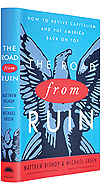Prosperity Lost and Regained
A review of The Road from Ruin, by Matthew Bishop and Michael Green.
(originally published by Booz & Company)The Road from Ruin: How to Revive Capitalism and Put America Back on Top
By Matthew Bishop and Michael Green
Crown Business, 2010
In The Road from Ruin, two Englishmen have attempted to combine a serious, balanced book on the root causes of the financial crisis and the Great Recession of 2008–09 with suggestions on how to remedy the situation and prevent such crises from happening again. The book’s introduction, which serves as an excellent executive summary, suggests that in the aftermath of the crisis, safe passage can be navigated between the opposing ideological perils of Karl Marx and Ayn Rand if fresh thinking is substituted for sloganeering.
In the book’s first part, the authors — Matthew Bishop is the U.S. business editor and New York bureau chief for the Economist and Michael Green is a London-based writer who taught economics at Warsaw University — identify five misconceptions about how the optimistic system of capitalism works: that financial bubbles are anomalies, that government should not bail out the financial sector in times of crisis, that financial symptoms should be addressed rather than economic causes, that the economy will recover naturally, and that tougher regulation is needed. In the five chapters that make up this first half of the book, they explain the role each misconception played in the cascade of events that led to the meltdown.
 The authors identify the fundamental cause of the financial crisis as global trade imbalances that were created by the United States’ persistent trade deficits and sustained both by the dollar’s status as a reserve currency and the reluctance of countries such as China to allow their currencies to appreciate. The result was a flood of U.S. dollars that drove up asset prices, especially housing, and reduced yields to investors. This created an ideal environment for financial innovations that offered high yields secured by ever-rising real estate prices.
The authors identify the fundamental cause of the financial crisis as global trade imbalances that were created by the United States’ persistent trade deficits and sustained both by the dollar’s status as a reserve currency and the reluctance of countries such as China to allow their currencies to appreciate. The result was a flood of U.S. dollars that drove up asset prices, especially housing, and reduced yields to investors. This created an ideal environment for financial innovations that offered high yields secured by ever-rising real estate prices.
The authors supply numerous examples from the past to reinforce their conclusions. Although the writing is lucid throughout the book, these five chapters are by far the best. They conclude with four conditions that must be met if capitalism is to survive: containment of systemic risk, protection of consumers and investors, streamlining of regulation, and international coordination of policy actions.
The second part of the book starts strongly, with coherent critiques of the concept of “economic man” and of the efficient market hypothesis. The authors argue convincingly for the creation of a regulator of systematic risk, as opposed to institutional risk, and for a new version of the 1944 Bretton Woods Agreement, which set the course for a high degree of global economic coordination after World War II.
But not all of the authors’ recommendations are as sound. For instance, they approvingly cite the MBA Oath developed by students in Harvard Business School’s class of 2009 (and taken by nearly half of the graduates), which affirmed that “greed is not good.” The authors appear not to recognize that this Boy-Scouts-in-the-brothel approach to regulation ignores the profoundly corrupting context that is Wall Street and the overwhelming power of incentives to shape human behavior and how it is rationalized. Worse still, the oath focuses attention on individuals rather than systems, making the same error that regulators and all those using value-at-risk calculations made during the run-up to the crisis, namely, measuring the risk exposures of a firm in isolation without accounting for what might happen if all firms were taking the same risks.
Similarly, the authors’ discussion of “philanthrocapitalism” (also the title of their previous book), which suggests that the efforts of a few wealthy individuals can help capitalism recover its “soul,” seems naive. This idea is curiously divorced from the realities of U.S. politics and power, and the difficulties of protecting consumers and institutions from both each other and themselves.![]()
Author profile:
- David K. Hurst is a contributing editor of strategy+business. His writing has also appeared in the Harvard Business Review, the Financial Times, and other leading business publications. Hurst is the author of Crisis & Renewal: Meeting the Challenge of Organizational Change (Harvard Business School Press, 2002).

